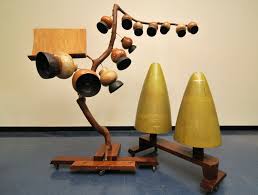
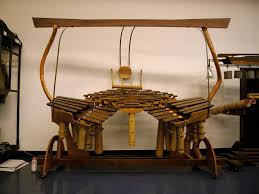
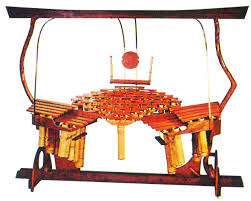
SA6: The Maker Issue


Introducing the Great Harry Partch
Listen to Harry Partch: The Dreamer That Remains - A Study in Loving


Diamond Marimba

Listen to the Diamond Marimba
The percussion instruments of Harry Partch are classified into three major categories, along with one ancillary group that contains small hand instruments used only in his Delusion of Fury. The first is the marimba type and includes, besides the Diamond Marimba, the Quadrangularis Reversum, Bass Marimba, and Marimba Eroica.
The Diamond Marimba is a practical musical representation of Partch’s diamond tonality, which is given a simple introductory explanation here.

Partch's diagram of the layout of the Diamond Marimba, which corresponds to his diamond tonality (from Harry Partch: Genesis Of A Music Da Capo Press)


Cloud Chamber Bowls
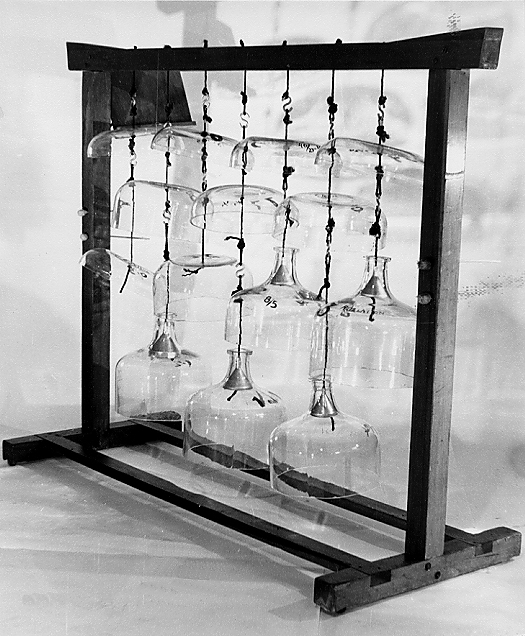
Listen to Cloud Chamber Bowls
The third subset of Harry Partch’s percussion instruments is made up of percussion instruments constructed using found materials and objects. This category included the Spoils of War, Gourd Tree and Cone Gong, and the Zymo-Xyl.

Notation:
Again, using the standard five line staff, each bowl is given a position, under which is written its ration and a number to help the player distinguish that pitches correlating bowl. To denote which of the striking styles should be used, on the edges or on the tops, different note head shapes are used: square for tops and the standard round noteheads for edges.
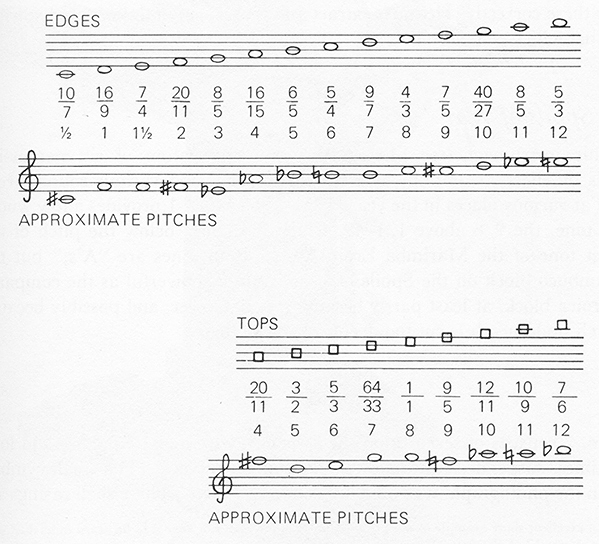
The Boos

Listen To The Boos
The Boos (Bamboo Marimbas) belong to the second classification of Partch percussion instruments, many of which are made from bamboo and use a tongue and resonator apparatus, in which the resonator is manipulated, usually by cutting notches to create a vibrating surface to be struck or “tongue” which activates the rest of the resonator.

Due to the mercurial nature of the material of bamboo, Partch used galvanized metal straps attached with a bolt around each portion. The bolt could then be tightened or released to help fine tune each section for performance.
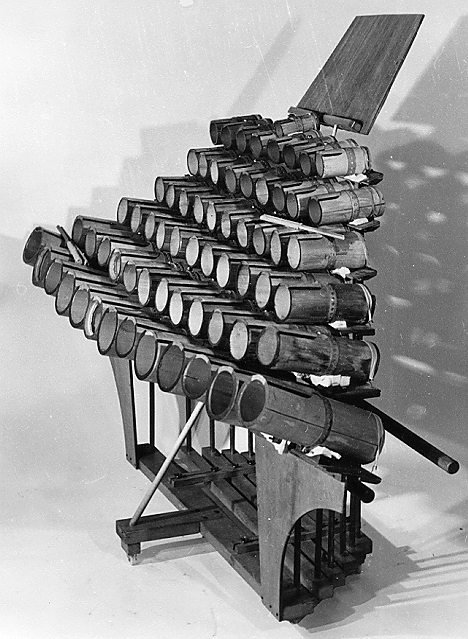

As opposed to a combination of bamboo from the Philippines and Japan, the Boo II uses only the Japanese Mozo type, which allows for more sonic predictability.

Harmonic Canons
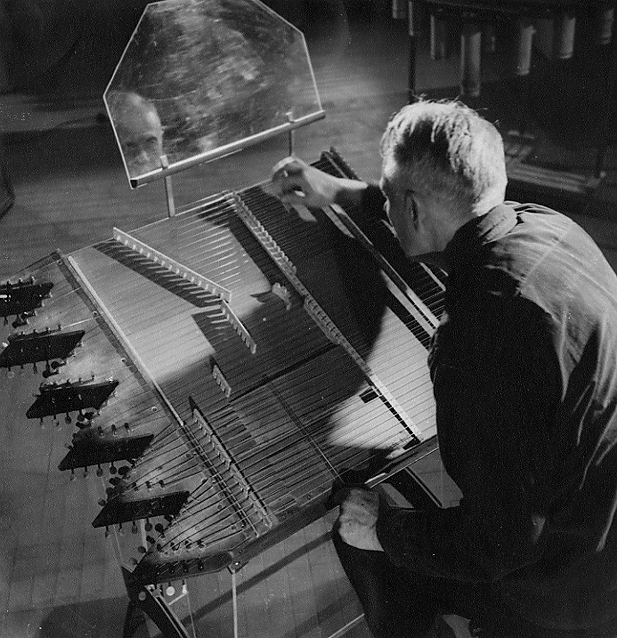
Listen To Harmonic Canon I
Another example of Partch’s stringed instruments is the Harmonic Canon. Like the Kithara, the Harmonic Canon had multiple iterations over the years, depending on the demands of Partch’s music, especially in regards to tunings.

Harmonic Canon II, however, takes the one large soundbox of Canon I and splits the 88 strings into two boxes of 44 strings each., essentially separating the A set and the X set and placing them over their own resonating surface. In Partch’s score, he denotes the separate sides of Harmonic Canon II by giving them names of the classical astral twins, Castor and Pollux. Each box has 44 strings, tuned to unisons or octaves, and a system of bridges to manipulate the strings for the player to perform the pitches, patterns, and scales in Partch’s score.

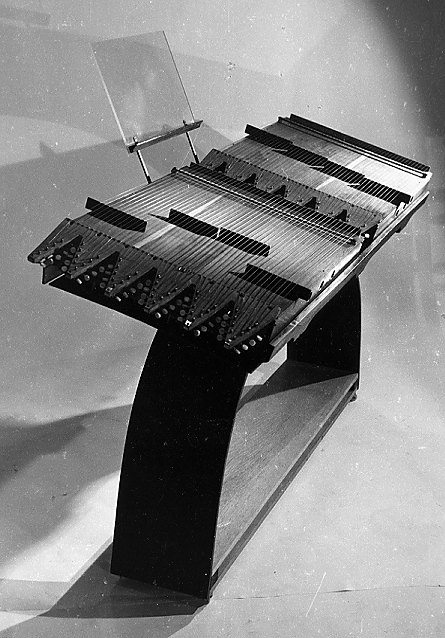
Harmonic Canon III, built in 1965, has three canons, but only two are used at a time. In the case of Canons II and III, the instruments are essentially “trays” that the canons can be placed in, two at a time, for performance. This allows for a more efficient change between the custom bridge arrangements necessary for different tunings.





The Kitharas

Listen To The Kitharas
Partch made three separate kinds of Kithara: Kithara I and New Kithara I (the Roman numerals of the instrument change, only if the concept of the instrument changes), Kithara II, and Surrogate Kithara.
All three instruments share the same basic construction that is found in the Kithara I: sets of strings over some sort of resonating soundboard, some of which use pyrex rods that are used to change pitch and tuning in performance.
Instruments that utilized strings make up a very important part of Harry Partch’s world: the first instrument of his own making was the Adapted Viola, which he played throughout his life. Although the Adapted Viola was a bowed instrument, playing techniques for some of his other stringed instruments may include percussive elements; their practical musical use tending to lean towards a standard plucking and string pressure approach. Of course, with an instrument like one from the Kithara family, this becomes the basis for a physical performance practice that expands into movable pyrex rods for ascending and descending glissandos which requires the performer to engage the instrument with a “…movement [that] is athletic, graceful, a kind of functional dance.”


The Kithara II was built in Sausalito in 1954 with the intent of broadening the range and especially the bass frequencies of the Kithara I. It consists of six large resonators, all at least five feet in length. The resonators and bridges are made of spruce and cedar and the added height necessary to reinforce the bass resonances required that a riser to be built to accommodate the performer. This, in turn, demands a physicality and theatricality that fits well with Partch’s interest in Ancient Greek drama.
The Surrogate Kithara was conceived as a way of providing a solution to the virtuosic Kithara part in 1952’s dance work Castor and Pollux, and is the most radically different of the Kithara family.
To begin with, it is a much smaller instrument, and is played while seated. It consists of only two resonators, as opposed to the Kithara II’s six. This configuration allows the performer a greater dexterity in changing the pitch by applying pressure to the strings, and opens up the instrument for use of percussion techniques on the strings.
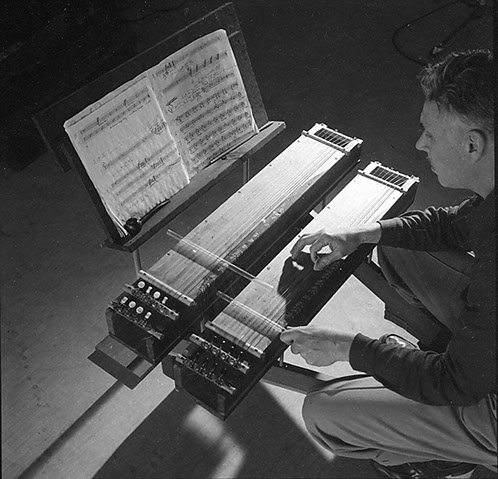

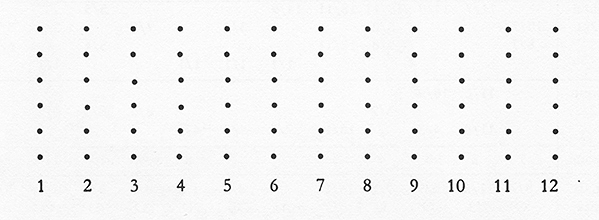
There are twelve courses of six strings. Each of these courses makes up a hexad, which could then be plotted as above

Partch then transferred this system onto a standard five-line staff with no clef or key signature, each note signifying one of the six strings

In the instance of a quick ascending or descending chord, Partch would notate the number of the string and the “notes” of the hexads through which the player should travel:
To play a single tone, the notation simply shows the number of the string and the position of the hexad at which it should be plucked:


When the composition requires the movement of the pyrex rods, Partch uses colors to denote their different positions. This takes into account the possible confusion between the numbers of the strings and hexads:
